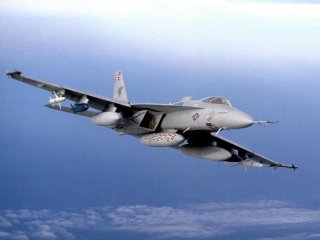This New U.S. Navy Missile Could Bring Non-Stealth Fighters Back Into Play
These new missiles will allow the U.S. to take out enemy air defenses from further distances and without compromising the F-35’s stealth, making this a significant development for the American military… but it could mean even more than that.
This makes the Navy’s new radiation-hunting missile a force multiplier in a high-end conflict, potentially bringing its fleet of F/A-18s out of reserves and into the fray. If adopted by other branches, it could feasibly do the same for the Air Force’s F-15 and F-16 fleets, as F-16s traditionally fill the “Wild Weasel” role.
Once the AARGM-ER goes into full production, it’ll offer America’s carrier-capable fighters a highly effective new tool for their toolbox, but even that won’t be enough to offset the area-denial bubble created by China’s long-range hypersonic anti-ship missiles. Finding a way to overcome this capability gap has been the focus of multiple efforts within the Navy and Marine Corps in recent years, but a magic bullet has yet to materialize. By some estimates, the only way to overcome the threat posed by weapons like China’s DF-21 and DF-26 anti-ship missiles is to field an entirely new aircraft with a significant increase in range. Others contend that these weapons have rendered massive aircraft carriers like America’s Nimitz and Ford-class vessels obsolete.
The problem really comes down to simple arithmetic. China’s hypersonic anti-ship missiles move too quickly to be intercepted by modern missile defense systems, and have claimed ranges in excess of a thousand miles. The term “hypersonic” refers to platforms that can travel at speeds in excess of Mach 5. America’s furthest-reaching carrier fighter, the F-35C, has a combat radius of around 650 miles, and the Block III Super Hornet’s new extended range will likely be in the same neighborhood. That means neither of America’s carrier fighters could feasibly engage Chinese anti-ship missile systems without putting their carrier within range–and at risk of being hit or even destroyed. Of course, accurate targeting at ranges in excess of a thousand miles is an incredible challenge, even when it comes to aiming for huge ships like aircraft carriers, but China has been working on its targeting apparatus for years and will continue to refine it for years to come.
Efforts like the MQ-25 Stingray carrier-based refueling drone, the Marine Corps’ Lightning Carrier concept, and even hot-loading short-take-off F-35Bs on austere island airstrips inside of China’s area denial bubble all aim to turn the arithmetic in America’s favor, but no single effort has managed the feat. Indeed, it may come down to multiple imperfect solutions, rather than finding a single perfect one. That is, until the next generation of carrier-fighters come to fruition.
If war between China and the United States were to unfold in the decades to come, it’s likely that B-21 Raiders would lead the way, engaging anti-ship weapons on China’s coast for carriers to come within striking distance to begin launching sorties of fighters, many of which will likely be equipped with the ARGGM-ER, to take out enemy radar installations and air defense systems.
This article was first published by Sandboxx News.
Image: Flickr

